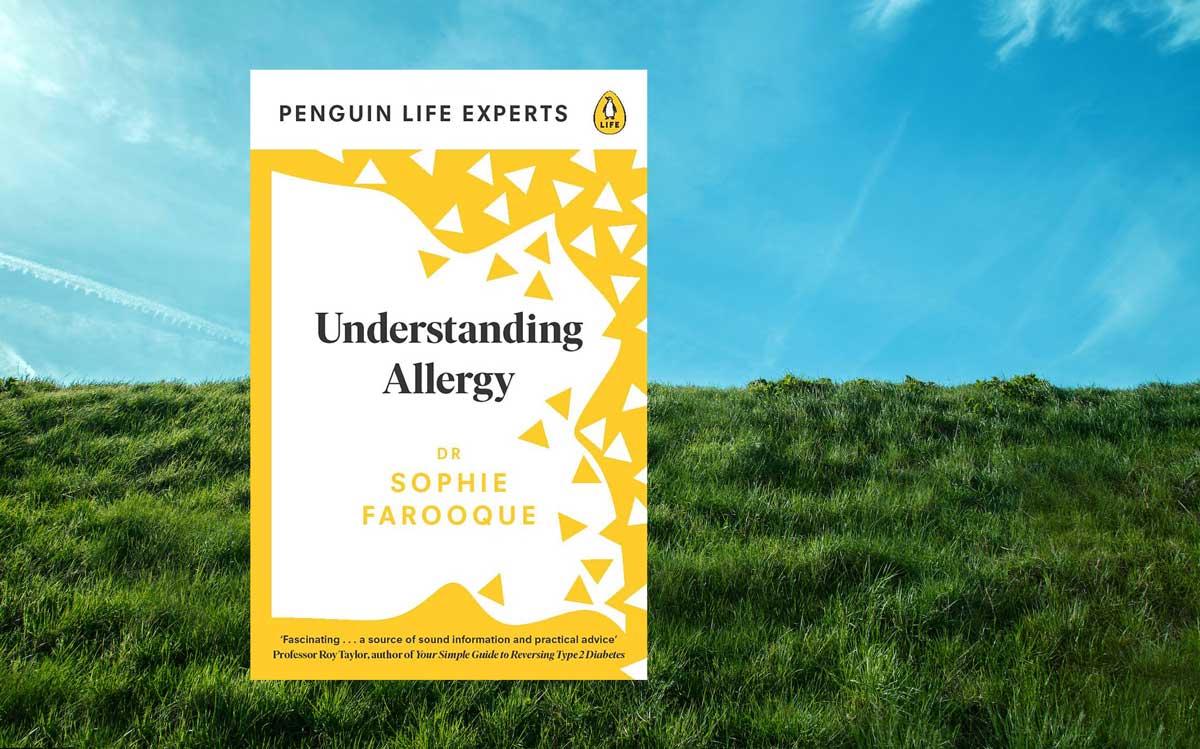Elke Hausmann is a salaried GP in Derby.
Understanding Allergy by Sophie Farooque, one of the UK’s leading allergy specialists who works at St Mary’s Hospital in Paddington, is a book that I think will have a profound effect on my practice as a GP. It is packed full of interesting facts but crucially, it also does exactly what it says on the tin — it helps you to understand allergy so much better.
Allergy — straightforward or baffling?
Allergy is a topic that at the same time seems very straightforward and utterly baffling. As GPs, we don’t even treat a lot of it anymore (patients with hayfever are first of all sent to the pharmacy), the treatments for eczema or asthma tend to follow step-by-step guidelines that are easy enough to implement (often by practice nurses), and on the other hand we refer straight on to allergy specialists if patients present with puzzling symptoms that may be allergic. If patients present with questions around food allergy, I often don’t really know what to say and do (and this happens a lot — 6 times more people think they have a food allergy than actually do have one! [p.73]).
It starts with eczema
“[This] is a book that I think will have a profound effect on my practice as a GP.”
So, I will start with what I have learnt about the relationship between eczema, asthma, and food allergies. First of all, food allergy does not cause eczema, eczema causes food allergy (p.173). Eczema is largely genetic, the main problem is a leaky skin barrier (because the ‘cement’ [filaggrin] between the ‘bricks’ [skin cells] is ‘crumbling’, letting bacteria, viruses, and food allergens enter the skin more easily, while moisture escapes [p.173–174]). Everything else follows from there.
If food allergens enter through the skin, the immune system may think it is under attack and causes an inflammatory immune response. This means practically that parents have to be careful with eating peanuts if they have a baby with eczema, as peanut dust spreads very easily throughout the house and may enter their leaky skin, priming the immune system to see peanut as a threat and increasing the risk of a peanut allergy once they start eating peanuts (p.25 and p.186). What I did not appreciate was that this is also a reason to discourage parents of very young children from using peanut oil, olive oil, or any other natural oil as skin moisturisers as they can increase the risk of allergy to those food products (p.177 and p.186). I will tell parents of that risk in future.
Halting the ‘atopic march’
Now, childhood food allergy increases the risk of asthma during adulthood nearly threefold (p.184), so it is actually fundamental to get on top of eczema in the first place to try to prevent the ‘atopic march’ — a study1 has shown that proactively getting on top of eczema using steroid creams led to an almost 50% reduction in the number of children developing a food allergy (p.184), and so will reduce their risk of asthma as well! That is amazing, as it means that as GPs we can fundamentally influence our patients’ future risk of illness simply by treating eczema as well as we can.
A meat allergy that might help with developing a new cancer treatment
The skin also plays an enormous role in the newly recognised alpha-gal syndrome (AGS), which is an allergy to a sugar in red meat (in itself unusual, as most allergies are to proteins) (p.90). It is thought that tick bites prime the immune system by introducing alpha gal though the skin, which can lead to an allergic reaction 2–6 hours after eating red meat. I was so intrigued by this that I researched it a bit more and found an article2 that argues that AGS and delayed allergy in general is an adaptive defence mechanism against cancer (humans lost the anti-gal molecule about 30 million years ago, so ever since then our immune system has seen it as foreign). You have to read the article but it is fascinating that our understanding of allergy may lead to better treatments against cancer.
Climate change and allergy
In April 2021, an article reported the first cases of meat allergy following tick bites in the UK (p.90). This brings me neatly on to the effects of climate change (increased temperature increases the survival and activity period of ticks). Climate change also has a massive impact on hayfever — the pollen season lengthens, pollen concentrations increase, and the geographical spread of species like ragweed known to cause hayfever increases (p.34).
“This book … has a wealth of information for individuals who want to control their allergy symptoms better.”
Then with climate change there are more thunderstorms, where updraughts of air can lift whole pollen grains into the clouds, where they can rupture following exposure to moisture, which can result in ‘pollen showers’, where fragments of allergens that are usually too big to enter the airways can cause severe asthma attacks in people who usually only suffer with hayfever. The largest known outbreak was in Melbourne in Australia in 2016, when paramedics responded to 1900 emergency calls and 10 people died (p.40).
More about hayfever
So, not only do we need to make sure that our patients’ hayfever symptoms are well controlled (and it is unfortunate that we don’t see many of them anymore) to prevent their risk of a severe asthma attack in the future, there are also other consequences of hayfever that are well worth knowing about (an increased risk of depression by 40%, car accidents due to uncontrolled symptoms, large amount of sick days costing the British economy £300 million a year in lost productivity, teenagers dropping grades in hayfever season, and having reduced sports attendance [p.32]).
On top of that, 80% of people with asthma also have allergic rhinitis, and controlling their rhinitis symptoms also improves their asthma (the ‘united airways tract theory’). In terms of what to advise people, saline rinses alone can improve rhinitis, as well as making sure that steroid nasal spray is better absorbed (p.49 and p.56).
Allergy is complex, but does not need to be baffling
“Once we really understand the ‘atopic march’ and the ‘united airways tract theory’, allergy makes a lot of sense.”
This book is aimed at the general public, and has a wealth of information for individuals who want to control their allergy symptoms better. GPs can learn a lot that they can pass on to their patients. One takeaway message is that allergy is complex, but does not need to be baffling. Allergy is not inevitable, the threshold dose at which a sensitised person develops allergic symptoms not only varies from person to person, but also for the same person with tiredness, exercise, viral illness, stress, alcohol, or co-factors like non-steroidal anti-inflammatory drug use. That’s why medical history is key, IgE blood tests and skin prick tests are only every supporting a diagnosis.
Relevant points for GPs
Once we really understand the ‘atopic march’ and the ‘united airways tract theory’, allergy makes a lot of sense. I haven’t even started on topics relevant to GPs like CMPA (cow’s milk protein allergy, causing 26% of all fatal anaphylaxis reactions in children in the UK [p.78]) and delayed CMPA (leading us to overprescribe specialist milks to babies with abdominal symptoms who are a bit ‘snuffly’ [p.93–94]), drug allergies (which anyone can develop at any point even if a drug was tolerated previously [p.144] — a case in point is an ACE-inhibitor-induced angioedema that can present after months or years on the drug [p162-163]), and the risks to the 3 million people in England who have a wrong label of penicillin allergy (which includes being more vulnerable to superbugs like MRSA and treatment failure with less potent antibiotics [p.142 and p.151]). The likelihood of developing a drug allergy, particularly to antibiotics, increases with the number of times you are exposed to them (p.144), which is another reason why we need to be very cautious with our antibiotics prescribing. I could go on and on.
Bonus paragraph on cat allergy
I will leave you with a fun fact about cat allergy. This is really allergy to a small sticky protein called Fel d 1, which is secreted in cat’s saliva and sebaceous and anal glands (p.43). When cats groom, this protein gets all over their fur, and thus everywhere they shed their fur or rub against — it has even been found in Antarctica where no cat has ever been (p.44)! If you are allergic, you are allergic to all cats, whereas you can be allergic to certain dog breeds but not others. And, while contrary to what is marketed, there are no hypoallergenic dogs, there is the prospect of hypoallergenic cat food, which dramatically reduces the amount of Fel d 1 made by cats and may eventually result in a reduction in symptoms in cat-allergic humans (p.45).
Featured book: Sophie Farooque, Understanding Allergy, Penguin Life, 2022, PB, 240pp, £9.19, 978-0241527887
References
1. Yamamoto-Hamada K, Kobayashi T, Mikami M, et al. Enhanced early skin treatment for atopic dermatitis in infants reduces food allergy. J Allergy Clin Immunol 2023; 152(1): 126–135.
2. Apari P, Földvári G. Tick bite induced α-gal syndrome highlights anticancer effect of allergy. Bioessays 2022; 44(1): e2100142.






